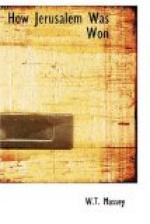On the night of October 30-31 a brilliant moon lit up the whole country. The day had been very hot, and at sunset an entire absence of wind promised that the night march of nearly 40,000 troops of all arms would be attended by all the discomforts of dust and heat. The thermometer fell, but there was not a breath of wind to shift the pall of dust which hung above the long columns of horse, foot, and guns. Where the tracks were sandy some brigades often appeared to be advancing through one of London’s own particular fogs. Men’s faces became caked with yellow dust, their nostrils were hot and burning, and parched throats could not be relieved because of the necessity of conserving the water allowance. A hot day was in prospect on the morrow, and the fear of having to fight on an empty water-bottle prevented many a gallant fellow broaching his supply before daybreak. Most of the men had had a long acquaintance with heat in the Middle East, and the high temperature would have caused them scarcely any trouble if there had been wind to carry away the dust clouds. The cavalry marched over harder and more stony ground than the infantry. They advanced from Khalasa and Asluj a long way south of Beersheba to the east of the town. It was a big night march of some thirty miles, but it was well within the powers of the veterans of the Anzac Mounted Division and Australian Mounted Division, whose men and horses were in admirable condition.
The infantry were ordered to be on their line of deployment by four o’clock on the morning of October 31, and in every case they were before time. There had been many reconnaissances by officers who were to act as guides to columns, and they were quite familiar with the ground; and the guns and ammunition columns were taken by routes which had been carefully selected and marked. In places the banks of wadis had been cut into and ramps made to enable the rough stony watercourses to be practicable for wheels, and, broken as the country was, and though all previous preparations had to be made without arousing the suspicions of Turks and wandering Bedouins, there was no incident to check the progress of infantry or guns. Occasional rifle fire and some shelling occurred during the early hours, but at a little after three A.M. the XXth Corps advanced headquarters had the news that all columns had reached their allotted positions.




